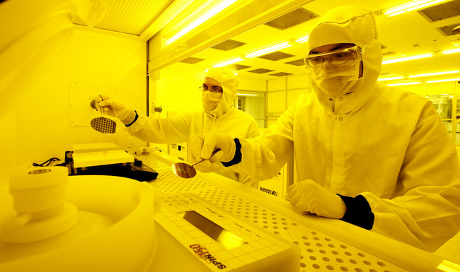
Engineers work on quantum devices at the Australian National Fabrication Facility
at the University of New South Wales.
Competing teams of Australian scientists have given that country a significant lead in an increasingly intense international competition to build a working quantum computer.
In an article that appeared on Thursday in the journal Nature, a team of Australian and British scientists, led from the University of New South Wales, reported that they had successfully constructed one of the basic building blocks of modern quantum computing by relying on manufacturing techniques now used by the modern semiconductor industry.
Quantum computing will potentially lead to a new generation of supercomputers that are not intended to replace today’s machines but will instead open new computing vistas, from drug and material design to code breaking, by offering speed to address a new class of problems.
“We are used to designing cars and airplanes with computers,” said Andrew Dzurak, a physicist who is director of the Australian National Fabrication Facility and lead researcher on the latest advance. “Imagine if you could start building your molecule or your material on a computer and then completely simulate its behavior.”
The basic building blocks of quantum computers are quantum bits, or “qubits.” Unlike today’s digital computers, which process information in a binary fashion based on logic states of “on” and “off,” a qubit can for brief periods represent multiple states simultaneously. Potentially, this means it is possible to tackle vast new problems by performing parallel computations using a relatively small set of qubits — perhaps as few as several hundred. The advance by Dr. Dzurak’s team involves placing a single electron — embedded in a silicon chip — in a “quantum state,” and then repeatedly measuring the state.
In February, a second group based at the University of New South Wales published an article in the journal Nature Nanotechnology reporting their advance: the construction of a single-atom transistor using a different but related design approach.
In both cases, the research teams are international. There is an increasing awareness, however, that Australian scientists have made significant advances this year toward this long-promised new type of computing.
While there is a growing consensus among scientists that working quantum computers will emerge during this decade, there is also a growing belief that they will not replace the conventional computers that are now carried in the pockets of more than half the world’s population. For one thing, most of the quantum computing approaches only worked when temperatures were cooled to near absolute zero.
Though there are only a handful of workable algorithms designed to run on quantum computers, scientists say their application may prove vastly more useful than today’s technology in simulating a wide variety of biological, chemical and physical systems. That means they could become the standard tool for a wide range of new industries, like drug and material design.
The achievements of the two teams is a payoff from an investment the Australian government began making in the 1990s.
“Both groups are highly competitive and leading in the world in what they do,” said Gerhard Klimeck, a professor of electrical and computer engineering at Purdue, who has collaborated with both groups and was a co-author of the Nature Nanotechnology paper.
Dr. Dzurak’s group’s work contrasts with a research team led by Michelle Simmons, director of the ARC Center for Quantum Computation and Communication Technology at the University of New South Wales. That group has taken an approach based on placing individual atoms using a scanning tunneling microscope, allowing great precision in building devices on an atomic scale.
The team led by Dr. Dzurak uses conventional semiconductor techniques to implant a phosphorus atom just 10 to 15 nanometers below the surface of a silicon chip. That approach has the twin advantages of using industry standards and potentially extending the individual electron’s duration in a quantum state.
The United States has federally financed, corporate and university research efforts under way to design usable quantum computers. I.B.M., for example, recently expanded its research at its Almaden laboratory in California.
Andreas Heinrich, a physicist who is a quantum researcher at I.B.M., pointed out that neither Australian group had shown the ability to interconnect multiple qubits. That capability is necessary for a quantum computer.
Dr. Dzurak said he believed that capability could be achieved as soon as a year from now.